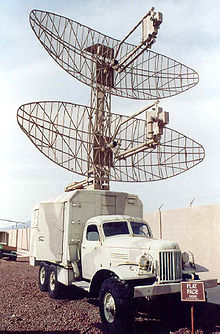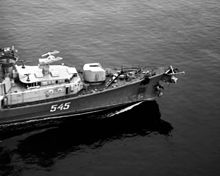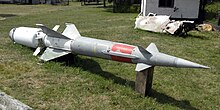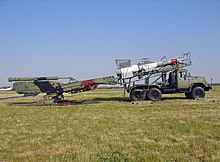S-125 Neva
The S-125 Neva ( Russian С-125 Нева , NATO reporting name : SA-3 GOA ) is a radar-guided air defense missile system with a two-stage rocket, which in the Soviet Union from the design office Isayev was developed and from 1961 the armed forces of the Warsaw Pact in action was.
Development and tactics
The S-125 is a further development of the S-75 system. The P-15 (Nato: Flat Face ) and PRW-11 (Nato: Side Net ) radars were largely taken over unchanged. The West learned of the system in early 1959 through a photo reconnaissance of the Kapustin Yar missile test site . At this point in time, final tests were carried out with the largely finished guided missiles. The first S-125 batteries were deployed around Moscow between 1961 and 1964.
The Soviet military leadership soon began to combine the S-125 with the long-range missiles of the type S-200 in brigades. Such a mixed brigade consisted of three divisions with six S-200 starters and two to three S-125 divisions with four starters each. When defending special goals, the systems were also combined with the S-75 system, all grouped under a common control system.
technology
The entire system is mounted on trucks and trailers, which makes it possible to change location quickly. On each truck - TEL there are normally two missiles on fixed starters usually up to four pieces. The following vehicles are required to operate an S-125 battery: a missile control station, a power supply unit and a cabin for the crew.
Radars
The radar complex allows two missiles to be guided at the same time. The volley shot is standard with this weapon system. It is always fired in double volleys, except when there is a lack of missiles. In the event of severe electronic interference , the target can also be captured using a video camera that can also be used at night. This is also necessary in many cases, as the S-125 hardly has adequate ECCM capacities compared to modern disruptive measures.

| Radar device | P-15 flat face | PRW-11 Side Net | Low blow |
|---|---|---|---|
| purpose | Surveillance / target acquisition | Height finder | Target tracking / fire control / steering |
| Frequency range | 0.83 GHz | 2-3 GHz |
|
| Max. Range | 200 km | 180 km |
|
| Pulse power | 300 kW | k. A. | 250 kW |
| Airtime | 1.5 µs | k. A. | 0.25-5 µs |
| Pulse repetition frequency | 500-660 Hz | k. A. |
|
| Distance resolution | 300 m | k. A. | k. A. |
| Angular resolution | 8 ° | k. A. | k. A. |
Guided missile
| Parameter | Data |
|---|---|
| length | 6.7 m |
| Takeoff weight | 400 kg |
| diameter | 0.6 m |
| drive | two-stage rocket motor + booster |
| speed | Do 3 |
| Range | 25 km |
| Minimal range | 3.5 km |
| Bet height | 18,000 m |
| Minimum bet amount | 100 m |
| Maximum target speed | 560 m / s (2016 km / h) |
| steering | Radio commands |
| Minimum target RCS | 0.5 m² |
| Warhead | 60 kg fragmentation warhead, highly explosive |
| Interference immunity | 200 W / MHz |
| ignition | Radar proximity and impact fuze |
| Effective radius | 12.5 m |
Marine version

A marine version was also developed parallel to the land-based version. This is known as M-1 Wolna (NATO code name: SA-N-1A ). The first test took place on board the destroyer Brawyi ( Kotlin class ) in 1962. The system was introduced that same year. The rocket 4K90 (also W-600) used has a range of 4 to 15 km and an altitude range of 0.1 to 10 km. Only one target can be fought at a time, and the system also has a surface-to-surface mode of operation that enables the missiles to be used against surface targets. The magazine of a ZIF-101 rocket launcher holds 16 rockets. Later, the ZIF-102 launcher, which can hold 32 missiles, was introduced on newer ships. The system was also delivered to Poland and India . The following radars are used:
| Radar device | MR-500 Big Net | MR-310 Head Net | 4R90 Peel Group |
|---|---|---|---|
| purpose | Surveillance / target acquisition | Target acquisition | Target tracking / fire control |
| Frequency range | 1-2 GHz | 2-4 GHz | 2-4 GHz |
| Max. Range | 300 km | 130 km | 42 km |
Modernizations
Marine version
The modernized variant Wolna-M (SA-N-1B), including the new guided missile 4K91 (W-601), includes the following improvements:
- Semi-active radar search head (possibly also infrared )
- New warhead
- Improved booster
- Increased range (6–25 km)
- Extended altitude range (0.1-25 km)
The modernization of Wolna-P includes the following improvements:
- Additional target channel for the video system
- Higher immunity to interference
With the Wolna-N variant , the improved W-601M guided missile was introduced, which can better combat particularly low-flying targets.
Land version
In the first modernization S-125M , the 4K91 (W-601) guided missile was introduced. The missile is based on the naval version and has a new booster and warhead. The subsequent modernization S-125M1 (SA-3B) includes various improvements. Guided weapons of the type W-601PD, W-601G, W-601GP and W-601GPU were used.
The most extensive upgrade was carried out as part of the Pechora-2A system. It is produced by the Belarusian company Tetraedr and is based on the S-125M1. According to the manufacturer, this modernization includes the following improvements:
- Improved ECCM capacities
- Reduced maintenance and longer service life
- Automatic tracking mode for the video system
- 50% of all analog assemblies were replaced by digital ones.
In addition, the new 5W27D guided missile is used.
| Parameter | Data |
|---|---|
| Range | 28 km |
| Minimal range | 3.5 km |
| Bet height | 20,000 m |
| Minimum bet amount | 20 m |
| Maximum target speed | 700 m / s (2,520 km / h) |
| Target acquisition | 2.5-3 s |
| Minimal RCS | 0.5 m² |
| ECCM immunity | 2000 W / MHz |
The company is currently working on the successor version , the Petschora-2TM . It should further increase the interference immunity (to 2700 W / MHz).
Poland has offered a modernization program for old S-125 systems since 2001. The designation is Neva SC . Many analog parts were replaced by digital ones and an IFF module and a data link were added. The launchers are mounted on a T-55 chassis, the radar on a MAZ-543 (previously used for mobile Scud launchers).
In the same year, the Russian systems were also modernized to the Pechora-M standard. This is a comprehensive upgrade in combat value that includes the following areas: rocket motor, radar, guidance, warhead, proximity fuse and electronics. In addition, a laser / infrared target system was integrated in order to determine the distance with optical accompaniment (tracking).
| Parameter | Data |
|---|---|
| Range | 30 km |
| Minimal range | 3.5 km |
| Bet height | 20,000 m |
| Minimum bet amount | 20 m |
| Maximum target speed | 700 m / s (2,520 km / h) |
| Target acquisition | Max. 3 s |
| Minimal RCS | 0.1-0.15 m² |
| ECCM immunity | 2,000 W / MHz |
At the end of 2008, a total of seven countries ( Venezuela , Libya , Syria , Egypt , Burma , Vietnam , Turkmenistan ) signed contracts for the delivery of Pechora-2M complexes with a total value of 250 million US dollars. A total of 200 guided missiles are to be delivered, with 70 going to Egypt.
commitment
The S-125 was used in some conflicts ( Kosovo War , Second Gulf War , etc.). In general, the system turned out to be ineffective, as the opposing forces often had powerful EloKa capacities and the operating teams were often insufficiently trained. On March 27, 1999, during the war in Kosovo, a US stealth bomber of the type F-117 Nighthawk was shot down by a Serbian S-125 unit. The circumstances have not yet been clarified exactly. It is believed, among other things, that the Serbs were able to determine the exact flight route of the F-117 through their secret service. What is certain is the fact that a network of three radar devices was established in order to increase the probability of detection . The use of the video system with night vision capabilities (or another retrofitted EO system) is also to be viewed as a realistic scenario.
User states
Note: States in italics are former users
- America: Cuba , Peru , Venezuela
- Europe: Yugoslavia , Serbia , Hungary , Bulgaria , Romania , Poland , Finland , GDR , CSSR , Russia , Slovenia , Ukraine
- Africa: Algeria , Angola , Ethiopia , Mozambique , Somalia , Tanzania , Zambia , South Sudan
- Middle East: Egypt , Libya , Syria , Yemen , Iraq , Armenia
- Middle East: India , Turkmenistan , Afghanistan , Pakistan
- East Asia: Myanmar , Vietnam , Democratic People's Republic of Korea
Comparable systems
Web links
- Additional information and pictures ( Memento from September 27, 2007 in the Internet Archive )
- S-125 at Peters-ADA.de
Individual evidence
- ↑ "Zenith" missile system S-200 , bastion-karpenko.ru, private homepage (Russian)
- ↑ Russia delivers S-125 missiles to seven countries on www.russlandonline.ru ; Accessed: December 29, 2008 (English)


